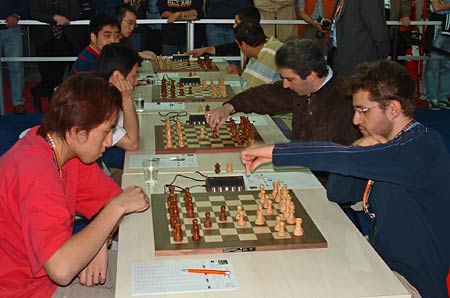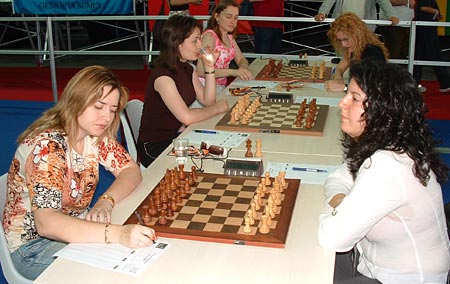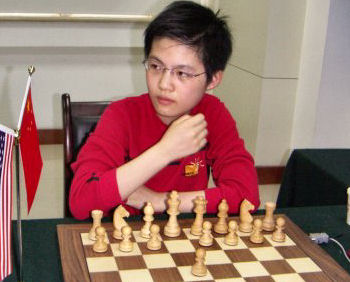| Latest | Greatest | Lobby | Journals | Search | Options | Help | Login |
|
|
|
This topic is archived. |
| Home » Discuss » Topic Forums » Sports |
|
| Jack Rabbit
|
Sun Jun-04-06 10:06 AM Original message |
| Chess news for week ending June 4: Olympics and Elections Edition |
|
Edited on Sun Jun-04-06 10:15 AM by Jack Rabbit
The Jack Rabbit Chess Report  Contents: Thread 1: Armenia and Ukraine win Gold at Torino Olympiad; American men take the Bronze Thread 2: Kirsan: four more years, western journalists express disappointment Thread 3: Annotated Games from Torino
Logo from Julia Beyer (Germany) |
| Printer Friendly | Permalink | | Top |
| Jack Rabbit
|
Sun Jun-04-06 10:07 AM Response to Original message |
| 1. Armenian men, Ukrainian women win Gold in Torino; US men take Bronze |
|
Edited on Sun Jun-04-06 10:11 AM by Jack Rabbit
The tiny Caucasus mountain nation of Armenia won the gold medal in the general division with 36 points while the team from Ukraine took the gold in the women's division with 29� points in the 37th Chess Olympiad completed today in the Alpine city of Torino, Italy.
The Armenian men's team was lead on the top board by Levon Aronian, the third-ranked grandmaster in the world. While Aronian's personal record was impressive (4 wins, 1 loss and 6 draws), the team was carried by the play of Gabriel Sargissian on the board 4 and Valdimir Akopian on board 2. Sargissian scored the most points for the team, 10, while Akopian contiributed 9 points. Sargissian's points tied him with Wang Yue of China for most points of any individual in the general division. The silver medal was won by China with 34 points, while the United States won the bronze medal with 33 points, beating Israel in tie-break points. Russia, favored by most at the start of the event to win the gold medal, faltered in the late rounds and finished with 32 points. Russia, which was in third place at the start of the final round was dealt a terrible blow when the team lost its final match to Israel, 3-1. The Americans leaped over several other teams to take the bronze by crushing Norway in the final round, 3�-�. The final standings in the general division are here.  The Armenian team (right) with Levon Aronian on the top board (foreground) in action in the crucial tenth round match against China The Armenians took the lead in the seventh round of the thirteen-round event with a 3-1 victory over Holland and then expanded their lead in the eighth round by defeating a strong team from Cuba 3-1. The Armenians defeated Ukraine in round 9 by a score of 2�-1�, with Sargissian winning the only decisive game of the match (see annotated games) from Alexander Moiseenko. However, on the same day, China crushed Georgia 4-0 to cut Armenia's lead in half and set up a showdown between the two teams the next day. Once again, all games were drawn save one, in which Akopian defeated Zhang Zhong on board 2 (see annotated games). That was the last serious threat to the Armenians in their quest for gold. In the women's division, Ukraine and Russia were in a tight race through most of the event, with the Russian women holding a half-point to a point lead until the tenth round. While the Russians drew against China, the Ukrainians crushed the Americans 2�-� in a match that featured a fine game on the top board won by Zhukova over US women's champion Anna Zatonskih, herself a native of Ukraine. That gave Ukraine a half point lead, which grew steadily to a point and a half by the start of today's action.  The Ukrainian team (left) with Natalia Zhukova on the top board (foreground) and Katya Lahno on board 2 taking on Spain in Round 6 The Russian women took the silver medal with 28 points and a strong Chinese team the bronze with 27� points. The United States finished in a tie for fourth with 24� points. The final standings in the women's division are here. The high scorer in the women's divsion was 12-year-old Hou Yifan, who played board 3 for China, with 11 points (10 wins, 1 loss and 2 draws). Most observers think this young lady will become a grandmaster in the next year or two. Her game in Round 11 against Ekaterini Fakhiridou of Greece is featured in the annotated games. Photos from ChessBase.com |
| Printer Friendly | Permalink | | Top |
| Jack Rabbit
|
Sun Jun-04-06 10:07 AM Response to Original message |
| 2. Ilyumzhinov re-elected FIDE President |
|
Edited on Sun Jun-04-06 10:20 AM by Jack Rabbit
Kirsan Ilyumshinov, who is also the President (equivalent of a state governor in the US) of the Russian Republic of Kalmykia, was re-elected to a four year term as President of FIDE, the world governing body of organized chess, at the FIDE Congress held this weekend in Torino, Italy.
  Kirsan Ilyumzhinov (left) and Georgios Makropoulos The vote, taken by delegates to the meeting Friday, was 96 votes for Ilyumzhinov and his slate and 57 votes for a slate headed by Belgian businessman Bessel Kok. Kok and his supporters accused the current FIDE leadership of corruption and of failing to attract corporate sponsorship for major FIDE events. Much of the criticism of FIDE's leadership was aimed at Deputy President Georgios Makropoulos. Grandmaster Bachar Kouatly wrote an open letter suggesting that Makropoulos has gambled with the FIDE prize fund of $1 million at an event held in Las Vegas in 1999, a charge that was denied by both Ilyumzhinov and Makropoulos. Nevertheless, the fact is that the prize fund was missing for a while, that those entitled to prizes in Las Vegas were late receiving them and that no satisfactory explanation has ever been given. Most of Kok's support came from Europe and the North America. Most of the former Soviet federations supported Ilyumzhinov In the closing days of the campaign, former world champion Garry Kasparov published an open letter to FIDE delegates urging a vote for Kok. While the result was not unexpected, the initial reaction among western jounalists has been one of bitter disappointment. International Master David Levy of Scotland, writing on ChessBase.com, recalled that many grandmasters opposed Ilyumzhinov over his handling of the world championship, speculated that more grandmasters will support a rival chess organization like the Association of Chess Professionals. Robert Huntington, formerly the Associated Press chess correspondent, said on his website: What happened yesterday was that Kirsan�s people completely outplayed Bessel�s people at the nasty game of politics and that trumped logic, reason, even the viability of the game of chess. A member of the American delegation compared Georgios Makropoulos to a Chicago ward boss and he was right. Makropoulos, he said, knows every federation intimately. He knows who�s really in power, what the local issues are, what the local federation needs, and he has no scruples abut providing it. Nigel Short�s clumsy African tour illustrated the gap between the two camps in political savvy. I always had the impression that there was a limit to how low Bessel Kok would stoop and that limit wasn�t low enough to give him any real chance of success. The harshest criticism of Ilyumzhinov in the wake of his re-election came from Malcolm Pein in a two part report on The Week in Chess (ChessCenter.com). Pein expressed pessimism at prospects for corporate sponsorship for FIDE evenst as longs as the current leadership is in power: I say eight years of stagnation because I don�t envisage another election in 2010 if that Olympiad is in Russia. There will be more years with little commercial sponsorship. Of course I would love to be proved wrong but my feelings are summed up by this little phrase: �Google FIDE au revoir�. Imagine the sponsorship manager of say a BT, Cisco or HSBC getting a chess proposal now. He will listen politely and having established the governing body of chess is FIDE he will put it into a search engine. What he will get back on screen is a basket case, just the stuff about Kalmykia will make them all run a mile and it will be �au revoir� to any hope of sponsorship. We will continue to see many events run in obscure places with poor conditions although the recent activity in Mexico is a chink of light. The players will continue to be mistreated and making a decent living from playing the game will continue to be just for a lucky few. Pein, echoing Levy, also said that the rival ACP may be the great hope for the future of organized chess. Photos from ChessBase.com |
| Printer Friendly | Permalink | | Top |
| Jack Rabbit
|
Sun Jun-04-06 10:07 AM Response to Original message |
| 3. Annotated Games from the Torino Olympiad |
|
Edited on Sun Jun-04-06 10:26 AM by Jack Rabbit
 Gabriel Sargissian Gabriel Sargissian (Armenia) vs. Alexander Moiseenko (Ukraine) Chess Olympiad, Round 9/Board 4 Torino, May 2006 Nimzo-Indian Defense 1. d4 Nf6 2. c4 e6 3. Nf3 b6 4. Nc3 Bb4 The opening is a hybrid of the Queen's Indian and Nimzo-Indian defenses. The Nimzo-Indian Defense (properly 1. d4 Nf6 2. c4 e6 3. Nc3 Bb4) is named for Aron Nimzovich, a Latvian grandmaster and theoretician who lived in Denmark between the two world wars and whose book, My System, is still widely read by serious chess players everywhere. The idea of the Nimzo-Indian is for Black to restrain White from advancing his King's Pawn while not committing to a central pawn structure of his own right away. 5. Bg5 Bb7 6. Nd2 h6 7. Bh4 Nc6 8. e3 Ne7 9. f3 White intends to control e4 and eventually occupy it. 9. -- Ng6 10. Bf2 e5?! Black might have considered 10. d5 and then regrouping the Queen's Bishop. 11. a3 Be7 12. d5 c6 13. Qb3 0-0 14. Bd3 cxd5 15. cxd5 Bc5 16. 0-0 Ne7 17. e4 As a consequence of Black's dubious 10th move, White has the better center and Black must still redeploy the misplaced Bishop. 17. -- d6 18. Bxc5 dxc5 19. a4! White, having the center locked down for the moment, moves to neutralize Black's space advantage on the Queen's wing. 19. -- Ng6?! With nothing on the Queenside, Black turns his attention to the King's wing. However, this plan is faulty. It might have been a better plan to play 19. -- Nh7 followed by -- g5 and -- f5, giving Black of a spatial advantage and some basis for launching an attack. 20. Rfd1 Nh5 21. Nf1 Qg5 22. Qc2! White has no trouble finding the right defensive move to meet Black's attack. 22. -- Nh4 23. Kh1 Rad8 24. Qf2 Bc8 Finally bringing the Bishop off the blacked diagonal, but there is no longer a good use for it. 25. g3 Ng6 26. Ne3 Ne7 27. a5 Kh8 28. axb6 axb6 29. Nc4 Bh3 30. Qe3 Qg6 31. Nxe5 Nxg3+? This looks like a mating sacrifice, but White refutes it and goes on to win. After the text move, Black's game is lost. Better is 31. -- QXe3 32. Nxe3 Bd7 before the Bishop is trapped behind enemy lines with a timely g4. 32. hxg3 Qxg3 33. Rd2 White still has sufficient defensive resources to repulse the last shadows of Black's attack. 33. -- f5 34. Rh2 fxe4 35. Bxe4 Qxe5 36. Rxh3 Nf5 37. Qf2 Nd6 38. Qh2 The initiative now passes to White, who is a piece ahead and more than ready to launch a decisive attack. 38. -- Qf6 39. Rg1 Nxe4 40. Nxe4 Qf5 41. Rg5 Qf7 42. Qe5 Kh7 43. Rhg3 Rd7 44. Rg6 c4 45. Nf6+ 1-0 Mate follows soon after either 45. -- gxf6 46. Rxh6+ Kxh6 47. Qf4+ or 45. -- Kh8 46. Rxh6+ gxh6 47. Nh5+.  Vladimir Akopian Zhang Zhong (China) vs. Vladimir Akopian (Armenia) Chess Olympiad, Round 10/Board 2 Torino, May 2006 Open Royal Game (Scotch Opening) 1. e4 e5 2. Nf3 Nc6 3. d4 exd4 4. Nxd4 This opening was a favorite of the nineteenth century, but was dormant for decades until Kasparov revived it in the last of his championship matches against Karpov (1990). 4. -- Bc5 5. Nxc6 Qf6 6. Qf3 The main line is 6. Qd2 dxc6 7. Nc3. 6. -- Qxf3 7. gxf3 bxc6 Also seen here frequently is 7. -- dxc6, from which Zhukova-Yang (Ekaterinaberg, March 2006) continued 8. Nd2 Ne7 9. Nb3 Bd6 10. Bd2 Ng6 11. Bc3 f6 12. h4 Be5 13. Nd4 h5 14. Be2 Nf4 15. Rg1 g6 16. Rd1 and White eventually won. 8. Be3 In the November 2004 Russian Championships (Moscow), Tseshkovsky-Morozevich continued 8. Rg1 Ne7 9. Be3 Bb6 10. c4 Bxe3 11. fxe3 O-O 12. f4 Rb8 13. b3 d6 14. Nc3 f6 15. c5 Be6 16. O-O-O Rfd8 with an advantage for White. Tseshkovsky-Lekic (Herceg Novi, May 2005) continued 8. h4 h5 9. Be3 Bxe3 10. fxe3 Ne7 11. Nc3 d6 12. O-O-O Be6 13. Ne2 Bc4 14. b3 Bxe2 15. Bxe2 a5 in a game that eventually ended in a draw. After White played 8. be3, as in the present game, Savxheno-Kiril Gregoriev (Moscow, February 2006) continued 8. --Bb6 9. c4 Bxe3 10. fxe3 Ne7 11. Nc3 d6 12. c5 Be6 13. O-O-O Rd8 14. Rd4 O-O 15. Ra4 and White won after 52 moves. 8. -- Bxe3 9. fxe3 Rb8 Radjabov-Harikrishna (Dos Hermanas, April 2005) continued 9. -- Ne7 10. Nc3 d6 11. O-O-O O-O 12. f4 f5 13. Bc4+ and the players agreed to a draw. 10. b3 Ne7 11. Nc3 d6 12. f4 f5 13. Rg1 0-0 14. Bc4+ Kh8 15. e5 dxe5 16. 0-0-0 White decides to forgo recapturing the Pawn in favor of controlling the open d-file. 16. -- Ng6 17. Rd3 Ra8 18. Na4 exf4! Black offers a Knight, in return for which he would get two advanced connected passed Pawns. 19. Rxg6? However, the sacrifice should not have been accepted. True, Black cannot take the Rook: 19. gxh6?? 20. exf4 any move 21. Rh3#. However, White may do better with the simple 19. exf4 Nxf5 20. Re3, when Black's Bishop has no good square and White threatens to play 21. Re7. If 20. -- Ng6 to guard against White's threat of putting a Rook on the seventh rank, then 21. Rxg6 simply wins the Knight, leaving Black no compensation whatsoever. 19. -- fxe3 20. Rg1 While this may not be a tacit admission by White that his 19th move was a mistake, the Rook must return to the bank rank before the Pawns march any further down the board. 20. -- f4 21. Nc5 Bf5 22. Rc3 Rae8 23. Be2 g5 24. Rxg5 Bc8 25. Bf3 e2! White must now return the sacrifice in order to stop the advancing Pawn. 26. Nd3 Re3 27. Bxe2 Rxe2 28. Ne5 Bf5 29. Nxc6 Rxh2 30. Nd4 Be4 31. Rxc7 f3! Now the second passed Pawn claims a piece as tribute for the sacrifice on Black's 18th move. 32. Nxf3 Bxf3 33. Ra5 Be4 34. Raxa7 Rg2 35. Rc4 Re8 36. b4 White's only reason for staying in the game is that he can make a fight of it if he can mobilize his Queenside mass of Pawns. 36. -- h5 37. Rc5 h4 Meanwhile, Black can still present White problems with his remaining Pawn. 38. Rh5+ Kg8 39. Rc7 Rg4 40. b5 Bg6 41. Rh6 Re1+ 42. Kd2 Re6 43. Rc8+ Kg7 44. Rch8 Ree4 45. b6 Black has lured the Rooks away from the Pawn mass and used his pieces to harass them. Now he will cut off the White King from the Pawns. 45. Rg2+ 46. Kc3 Rg3+ 47. Kd2 Rd4+ 48. Ke2 Mission accomplished. 48. -- Rc4 49. Rxg6+ Kxh8 50. 0-1 Zhang resigns. White's Pawns will fall like summer fruit.  Natalia Zhukova Anna Zatonskih (United States) vs. Natalia Zhukova (Ukraine) Chess Olympiad, Round 9/Board 1 Torino, May 2006 King's Gambit: Abbazia Defense 1. e4 e5 2. f4 The King's Gambit, the staple of chess masters a century and a half back, is seldom seen in master play nowadays; its few twentieth century adherents have included Rudolf Spielmann, David Bronstein and Boris Spassky. It is missed by those who love swashbuckling chess. 2. -- d5 3. exd5 exf4 4. Nf3 The usual move order for the Abbazia Defense is 1. e4 e4 2. f4 exf4 3. Nf3 d5 4. exd5. The move order chosen by Black shows Ms. Zhukova had thoughts of playing the Falkbeer Counter-Gambit (1. e4 e5 2. f4 d5 3. exd5 e4 4. d3 Nf6). 4. -- Qxd5?! This isn't a novelty, but it is seldom played and has a dubious record. The main line is 4. -- Nf6 5. Nc3 Nxd5 6. Nxd5 Qxd5, when White cannot gain time by attacking the Queen as in the present game. 5. Nc3 Qa5!? However, the usual move in this case has been 5. Qh4. This move may be quite a bit better. 6. Bc4 Nc6 7. Qe2+ Be7 8. Nd5 Be6 9. Nxe7 Ngxe7 10. Bxe6 fxe6 11. Qxe6 Rf8 12. c3? A small piece of compensation to Black for the fifth move is that White experiences some problems to developing her Queen's Bishop. Nevertheless, 12. 0-0 followed by an advance of the d-Pawn may have been better. 12. -- Rf6 13. Qe4 0-0-0 14. 0-0 Qh5 15. d4 g5! Initiating the typical Kingside counterattack of a King's Gambit. 16. Bd2 Ng6 17. d5 Nce7 18. c4 Nf5 19. Rae1 g4 20. Ne5 g3 21. h3 The threat was immediate checkmate; however, if 21. Nf3 then 21. -- Ngh4 22. hxg3 fxg3 23. Re2 Nxf3+ 24. gxf3 Nd6 leaves White looking shaky. 21. -- Re8 22. Bxf4 Nd6 23. Qd4 Rxf4!! This is a fine sacrifice; Black gets two minor pieces for the Rook. 24. Rxf4 Nxe5 25. Ref1 Nexc4 26. Qxa7 Qxd5 27. Qa8+ White is able to put on only a hint of an attack which Black has no difficulty repulsing. 24. -- Kd7 28. Qa4+ b5 29. Qc2 Ne3 Now White must return the exchange with the result being that Black is a whole piece to the good. 30. Qe2 Nxf1 31. Qxf1 Qc5+ 32. Kh1 Qe5 33. 0-1 Ms. Zatonskih resigns, since the endgame is hopeless after 33. Kg1 Qe1 34. Qxe1 Rxe1+ 35. Rf1 Rxf1+ 36. Kxf1 Ne4.  Hou Yifan Hou Yifan (China) vs. Ekaterini Fakhiridou (Greece) Chess Olympiad, Round 11/Board 3 Torino, June 2006 Open Sicilian Game: Najdorf Defense 1. e4 c5 2. Nf3 d6 3. d4 cxd4 4. Nxd4 Nf6 5. Nc3 a6 6. f4 The more usual methods of meeting the Najdorf Defense are 6. Bg5, 6. Be3 and 6. Be2. 6. -- e5 7. Nf3 Nbd7 8. a4 White must try to neutralize Black's queenside spatial advantage. 8. Bd3 b5 9. 0-0 Be7 10. Kh1 0-0 and 8. Bc4 b4 9. Bd5 Rb8 are evaluated as giving Black an equal game (MCO-14). 8. -- Be7 9. Bd3 0-0 10. 0-0 exf4 Black gains nothing postponing the Pawn exchange. Psakis-Balshov, quoted in MCO-14, went 10. -- Nc5 11. Kh1 d5 12. Ne5 dxe4 13. Be2 Qc7 14. Be3 b6 15. Qe1 Bb7 16. Qg3 Rad8 17. Rad1 with a slight advantage for White. 11. Bxf4 Nc5 12. Kh1 A prophylactic move to take the King off the exposed diagonal should Black decide at some point to play -- Qb6. 12. -- Bg4 13. Be3 Rc8 14. Qd2 It seems best to break the pin. MCO-14 quotes Kindermann-de Firman (Biel 1995): 14. Qe1 Bh5 15. Nd4 Ng4 16. Nd5 Bh4 17. Qd2 Re8 18. Nf5 Nxe3 19. Qxe3 Bg6 20. Qd4 Re5 "with even chances." 14.-- Bh5 15. Nd4 Bg6 16. Nf5 Bxf5 17. Rxf5 g6!? This move seems weakening, but there is no other way to attack the intrusive Rook. 17. -- d5, intending to undermine the Rook, fails to 18. Nxd5 Nxd5 19. Rxd5 Qc7 20. Bf4 when not only is the Rook still on the fifth rank, but Black's pieces are looking for cover; 17. -- Qd7 is little better after 18. Bxc5 Rxc5 19. Raf1. 18. Rf3 White shows that she intends to continue with her Kingside attack. 18. -- Ng4? Black is afraid of 19. Bh6 Rd8 20. Rxf6 Bxf6 21. Qf4 followed by 22. Bc4, but she should seek counterplay in the center with 18. -- Ncd7 19. Bh6 Ne5. 19. Nd5 Nxe3 20. Qxe3 Bg5 21. Qd4! A fine move taking control of the open long diagonal. 21. -- Nd7 The focus of White's pieces is f6; Black moves to defend the point. 22. Raf1 Ne5 23. Rg3 f6 24. c3 Kg7 25. Bc2 Rc4 Black thinks she has found a way to drive White away from the center and commences with operations on the Kingside. 26. Qd1 h5 27. h4 Bxh4 28. Nf4!! The sacrifice of the Rook gains White the Queen and a Pawn for the further price of a Knight. 28. -- Bxg3 If 28. -- Re8 then 29. Rxg6! Nxg6 30. Nxg6 Kxg6 31. e5+ Kh6 32. Qd3 and Black must return the Rook and then find a way to protect her exposed King. 29. Ne6+ Kh7 30. Nxd8 Rxd8 31. Rxf6 White has emerged with a superior position. 31. -- Kg7 32. Rf1 d5 33. Qd2 Rd6 34. Qg5 Ng4 35. Qe7+ Kh6 36. Rf7 1-0 White threatens checkmate with 37. Rh7. The only way to prevent this is to surrender the Knight with 36. -- Nf6 37. Rxf6 Rxf6 38. Qxf6. Ms. Fakhiridou resigns. Photo credits for this week: Gabriel Sargissian from the website of the 1006 Gibralter Chess Congress Vladimir Akopian form ChessBase.de Natalia Zhukova from chessBase.com Hou Yifan from ChessBase.com |
| Printer Friendly | Permalink | | Top |
| DU
AdBot (1000+ posts) |
Thu May 02nd 2024, 01:47 PM Response to Original message |
| Advertisements [?] |
| Top |
| Home » Discuss » Topic Forums » Sports |
|
Powered by DCForum+ Version 1.1 Copyright 1997-2002 DCScripts.com
Software has been extensively modified by the DU administrators
Important Notices: By participating on this discussion board, visitors agree to abide by the rules outlined on our Rules page. Messages posted on the Democratic Underground Discussion Forums are the opinions of the individuals who post them, and do not necessarily represent the opinions of Democratic Underground, LLC.
Home | Discussion Forums | Journals | Store | Donate
About DU | Contact Us | Privacy Policy
Got a message for Democratic Underground? Click here to send us a message.
© 2001 - 2011 Democratic Underground, LLC